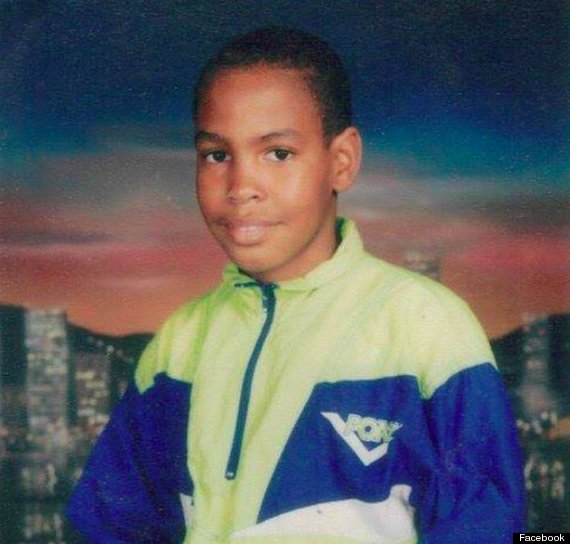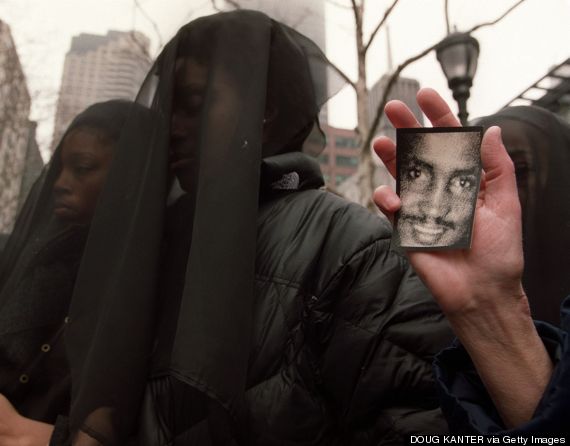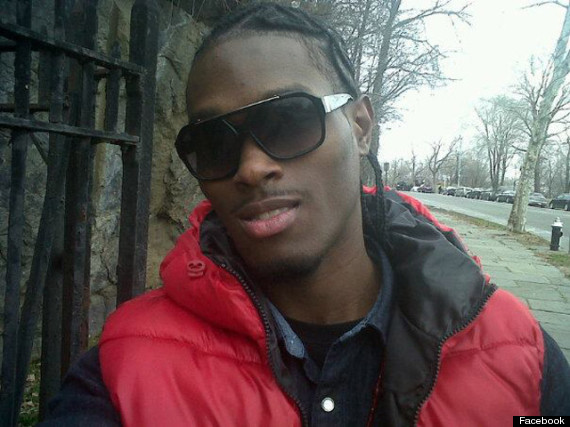December 3, 2014 | When an Albuquerque police officer shot his 22-year-old son to death, Mike Gomez was determined to crusade for justice. Three years later, he is simply despondent.
“It’s so frustrating,” Gomez told me. “There’s no accountability here. There’s no justice. There’s no respect. There’s no humanity here. There’s nothing. It’s so disgusting that they get away with it.”
A single father, Mike Gomez struggled for years to help his son, Alan, cope with a substance abuse problem. When Mike Gomez left town on May 10, 2011, Alan Gomez fell back into his addiction and was overcome with paranoid delusions. He began pacing back and forth on the front lawn of his brother’s house, holding a conversation with an imaginary person about gang members assembling to kill him. Alarmed family members eventually phoned a dispatcher from the Albuquerque police, who summoned police to what she mistakenly believed was a hostage situation.
From across town, an off-duty cop named Sean Wallace heard the alert blare through his scanner, then barreled over to the scene before a crisis intervention officer could arrive. Without provocation, Wallace opened fire, killing Alan Gomez with a high-powered rifle as he entered the house through a screen door. The troubled young man was holding nothing in his hand but a plastic spoon.
With his death, Alan Gomez joined the list of at least 27 people killed by Albuquerque police officers since 2010, and the more than 40 wounded by gunfire. In a city of just over 540,000, the body count is staggering. Indeed, the rate of officer-involved shootings by Albuquerque police is
eight times that of the NYPD and two times higher than in Chicago, a megalopolis with one of the steepest levels of violent crime in the country.
Alan Wagman, an assistant public defender who served on Albuquerque’s Police Oversight Commission, told me he observed a pattern of brutality that extended well beyond the shooting of unarmed people. He described witnessing numerous cases of officers applying a technique known as a “sternum rub” to homeless people. “They take their knuckles and hold it against the breastbone, push and rub back and forth,” Wagman explained. “The pain is so extreme only a comatose person wouldn’t wake up. So cops will come upon a passed out drunk, give him a sternum rub, the person wakes up and hits the cop and they charge him with assault on a peace officer. I’ve seen this more than once. It’s clear they’re trained to do this.”
Wagman described the Albuquerque police as the most violent department he has ever encountered in his career as a public defender. “I think they’re trained to kill people,” he said. “I can’t understand it any other way.”
A damning
report released this April by the Department of Justice concluded that the “Albuquerque police department engages in a pattern or practice of unconstitutional use of deadly force.” It went on to accuse members of the department of having “shot and killed civilians who did not pose an imminent threat of serious bodily harm or death to the officers or others.” The report singled out Wallace for killing Gomez when “no one’s life was in danger and an APD negotiator was on his way to the scene.”
When I visited Albuquerque this October, local civil liberties activists explained the city’s plague of lethal police violence in a broader context of racism and economic inequality. The legacy of settler-colonialism and its echo in the immigration crisis has cultivated an atmosphere of racially charged brutality. The state’s economy subsists off of the arms industry, military contracts and nuclear research, fueling a militarized culture that filters down to local police forces. Albuquerque is at the crossroads of major drug-running route, making it a central staging ground for the federally funded war on drugs. Add to the equation a plethora of casinos, a dearth of jobs and a local government operated by a tax-slashing mayor overseeing a corrupt patronage network and it becomes clear why the blighted metropolis known as Duke City has become a virtual playpen for killer cops like Sean Wallace.
A Killer’s Rewards
Wallace joined the Albuquerque police in 2007 during an ill-fated push to expand the force to 1000 officers. He was among four officers who had just been fired from the New Mexico State Police for taking payments from Wackenhut, a private security contractor, while on duty as state cops. The four barely averted prison terms for the double-dipping scandal.
When the rejects were hired by the Albuquerque PD,
then-Deputy Police Chief Mike Castro pledged, “They do not carry guns, they are not going to be badged.” Almost as soon as Wallace reported for duty, however, he was sporting a badge and bearing an assault rifle.
Besides killing Alan Gomez, Wallace has shot two other unarmed people in his short career — one died — and terrorized an untold number of others. He was named in a federal lawsuit for
ramming the car of a wanted man driving his family to school, then handcuffing the man’s children as their schoolmates watched in horror. Though his killing of Gomez cost Albuquerque $900,000, part of a whopping $26 million tab in settlements paid out to families of citizens killed by cops since 2010, Wallace has received nothing but rewards from his superiors. (The first time he killed an unarmed person, Wallace cost the city $235,000.)
For shooting Gomez, the Albuquerque Police Officers Association
paid Wallace $500 and gave him three days off. Other cops who shot local residents have received checks ranging from $300 to $1000, along with several days of leave—payouts the police union calls “decompression money.”
Wallace has since received a special
commendation for distinguished service and was promoted to sergeant. Despite changing the story of how he killed Alan Gomez several times during his deposition, Wallace has been
elected to the Albuquerque Police Officers’ Association’s executive board as the area representative for police supervisors. Chief among his duties is coaching other officers on how to structure their testimonies when they appear before Internal Affairs investigators.
“Wallace is laughing at me right now,” Gomez said. “He got money, he got a promotion, and now he’s coaching other cops on how to lie.”
Perhaps the only consequence Wallace has faced for his lethal violence was being shamed by protesters into withdrawing as a contestant from the city’s 2014 National Police Shooting Championships. Nicknamed by local anti-brutality activists the “
Killer Cop Competition,” the target-shooting jamboree was overseen by Tim Gonterman, a local police officer who tased a homeless man until his ear fell off. (The 2002 incident cost the city $300,000 in an excessive force lawsuit.) Gonterman has since been promoted to the rank of major and appointed to oversee the reforms demanded by the Department of Justice. Albuquerque Police Chief Gordon Eden proudly
declared that Gonterman has “demonstrated the strong leadership skills necessary for us to move ahead with DOJ reform requirements.”
Partner in Crime
Wallace’s partner, Jeremy Dear, has also demonstrated a penchant for deception and wanton violence. Dear was caught lying to investigators during his deposition on the killing of Alan Gomez. He claimed he saw Gomez carrying something resembling a firearm when Wallace shot him. However, in audio recorded on his lapel camera when the incident took place, Dear clearly stated he could not even see Gomez’s hands.
This April, just two weeks after the DOJ released its report on the Albuquerque police, Dear shot and killed a 19-year-old named Mary Hawkes under suspicious circumstances. Dear claimed Hawkes had stolen a truck, then drawn a .32 pistol on him when he attempted to arrest her. In the end, Hawkes was found shot three times at a 60-degree
downward angle, indicating she was lying down when killed.
Curiously, Dear could not produce any video from his lapel camera that captured his shooting of Hawkes. It was the fourth time that video from his camera had mysteriously disappeared. At Police Chief Eden’s press conference on the incident, he
displayed a replica of the gun Hawkes was accused of pointing at Dear, raising questions about the whereabouts of the real pistol. To Hawkes’ bereaved friends and supporters, it appeared the department was determined to sweep another killing under the rug along with the life of a homeless young woman city leadership seemed to view as disposable.
Raised in foster homes and drawn to the street in search of a community, Mary Hawkes fit the profile of so many other victims of the Albuquerque police. During a stint at the Bernalillo Juvenile Detention Center, she earned her GED and
articulated through poetry her harrowing experience as a homeless teen born to abusive parents. On the streets of Albuquerque’s gritty International District, she and her friends sometimes broke into cars or vacant homes in search of places to sleep. It was there, under circumstances that will never be fully known, that Hawkes encountered the cop who would cut her life short.
This month, Dear was
fired for repeatedly turning off or tampering with his lapel camera. But it remains unlikely that he will ever be indicted for killing Hawkes. Meanwhile, Police Chief Eden has declared that the department’s most violent elements may be intractable.
The Killer Cop Clubhouse
Within the Albuquerque police department, a little-known elite unit serves as a de facto clubhouse for some of its most violent members. It is a hyper-militarized anti-gang force known as the Repeat Offender Project, or ROP. For the past two decades, the team has chosen a hangman’s noose as its symbol. As
Jeff Proctor reported for Albuquerque’s News 13, “The [ROP] team plastered the ominous insignia all over its wanted posters, internal memos and other documents.”
ROP members are drawn increasingly from SWAT teams, dress in plainclothes and function separately from the rest of the police force. Its leadership has refused to publicly disclose the names of officers in the unit. According to Proctor, a number of ROP officers have been funded by the New Mexico State Police “to receive training that has its roots in preparing soldiers for America’s wars in the Middle East and elsewhere” at a Department of Energy military training ground in the desert.
“I think of [ROP] like a fight club,” civil rights attorney Shannon Kennedy remarked to Proctor. “They truly are cowboys. There’s no supervision, and there’s no chain of command. The ROP team does whatever it wants.”
Though it is only comprised of a handful of members, the ROP is responsible for at least one out of every 10 officer-involved shootings since 2005. The videotaped shooting this April of a mentally ill homeless man, James Boyd, by ROP detective Keith Sandy was far and away the team’s most notorious killing, sparking a storm of protest and forcing a national spotlight on the Albuquerque police’s culture of brutality. (Watch the embedded video at the bottom of this article.)
Like Wallace, Sandy was among the four rejects fired from the state police for accepting payments from Wackenhut while on duty. Somehow, he worked his way through elite units until he reached the ROP team, where he received military-style training at the Department of Energy facility.
As soon as he arrived at the Eastern Mountain ravine where Boyd was found camping without a permit, Sandy remarked in
murky audio captured by a fellow cop’s dashcam, “That fucking lunatic, I’m gonna shoot him with a [unintelligible] shotgun.” Others who examined the audio heard Sandy pledge to “shoot him in the penis with a shotgun.”
After a three-hour standoff, Boyd suddenly gathered his belongings and appeared ready to surrender. Just then, the officers inexplicably fired a flash-bang round at his feet and released a police dog, prompting Boyd to reach for two small knives. When Boyd turned his body in apparent compliance with an order to get down on the ground, Sandy fired three bullets into his back with a modified M-4 assault rifle. Sandy’s partner, Dominique Perez, riddled him with bullets as well. The cops spent the next minute pelting Boyd’s lifeless body with beanbag rounds.
Footage of the killing astonished Joe Kennedy, a civil rights attorney who had previously won a $10 million settlement from the Albuquerque PD. “I’ve never seen a murder captured on videotape before,” Kennedy told the local news outlet, Channel 7. “If this doesn’t convince this chief and this mayor that officers are out there killing people without justification, I don’t know what will.”
Outrage and Unrest
Police Chief Eden spun the killing just as Kennedy feared. At a press conference, he described the officers’ actions as “justified,” claiming that Boyd “directed a threat” toward a canine officer who was, in fact, well out of Boyd’s reach. Eden offered a version of events that stood in stark contrast to the video evidence. For his part, Keith Sandy eluded punishment with help from the police union and tacit support from the department. In the wake of Boyd’s killing, only 36% of Albuquerque
residents expressed confidence in the city’s police force.
Citywide outrage boiled over into open rebellion as nearly 1000 demonstrators marched next to the campus of University of New Mexico on March 30. After a day of raucous but mostly peaceful demonstrations led by family members of police shooting victims, cops in riot gear let loose a fusillade of teargas and moved in to make arrests. “Seemingly out of nowhere the police began charging them, we saw teargas go off, we even got maced out here as the wind is just blowing everything around,”
remarked News 13 correspondent Cole Miller.
The protest and its violent suppression galvanized the local movement against police brutality. “For the first time we have pressure and we’ve exposed the violence of the APD like never before,” Sayrah Namaste, a coordinator at the American Friends Service Committee-New Mexico, told me. “The families feel like there’s momentum and pressure that wasn’t there. Now we have a moment where a microscope is on the cops and they’re all on edge.”
Activist pressure has forced Mayor Richard Berry to shrink from public view, hiding from potential protests at major city festivals like Summerfest and Cesar Chavez Day. Meanwhile, the city council has taken measures to
restrict public demonstrations during its meetings. As the blood continues to flow, one of the few whistleblowers to emerge from the ranks of the Albuquerque police is living in fear.
“Nothing’s Gonna Happen Here”
In 2006, at a roadblock set up by the Bernalillo County Sheriff’s Department, Albuquerque police veteran Sam Costales’ life changed forever. Ordered to help turn back traffic, Costales witnessed several sheriffs brutally arrest the famed race car driver Al Unser Sr. as he attempted to return to his home in the neighborhood they had blocked off. When Unser was baselessly charged with resisting arrest, Costales agreed to testify in his defense, helping to exonerate the local legend.
While none of the officers who violently arrested Unser faced punishment, Costales was disciplined for wearing his uniform while testifying in Unser’s defense. (Albuquerque cops are only allowed to appear in police dress as witnesses for the prosecution). For violating what he called “the blue wall of silence,” Costales was about to be destroyed.
After then-Police Chief Ray Schultz condemned Costales for testifying in Unser’s defense, Costales fell victim to a retaliatory campaign orchestrated by the Albuquerque Police Officers Association, the main police union. “APOA started writing nasty shit on me on chat forums,” Costales told me. “They said, ‘Don’t give him backup, he will inform on you.’ I had to do my job totally alone without backup on calls and was eventually ordered to see a psychiatrist. They said I was a danger to myself and others.”
As one of the few members of the Albuquerque PD to speak out about the culture of violence he witnessed throughout his career, Costales is left to wonder if the retaliation will ever end. “I’m alone today,” he said. “I’ve got no friends at the police department. I never carried a gun for 24 years as a cop when I was off duty, but I do now.”
Costales has watched with dismay as APOA vice-president Shaun Willoughby explains away shooting after shooting regardless of the circumstances while defending the election of violent cops like Wallace to the union’s board. Costales views the city government as hopelessly corrupt, Police Chief Eden as a feckless character with minimal field experience, and District Attorney Kari Brandenburg as a police tool.
This October, the city
reached an agreement with the DOJ to implement a regime of reforms including de-escalation training and the disbanding of notoriously violent units like the ROP. But the deal means little to a former insider like Costales. “Nothing’s gonna happen here,” he said. “The police are gonna keep doing what they’re doing. They’re just thumbing their nose.”
Mike Gomez shares Costales’ skepticism. “There’s gonna be nothing but some new training for the cops,” he said. “There’s no accountability and there won’t be any indictments. We’ve gotta show them that they might go to court if they kill. Right now their badge is a license to kill and they know it.”
After three years of struggling in vain for a taste of justice, Gomez suddenly finds himself battling against hopelessness. “Sometimes I just want to walk away,” he said. “I can only do so many years of this stuff













